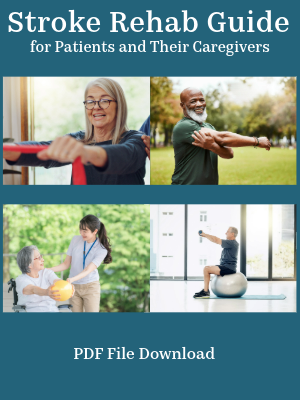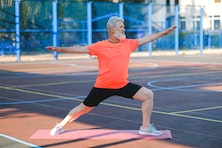Submissions from Readers
Pain After Stroke
by Elizabeth
(La Puente)
Question: Why is my father having pain on the side he lost strength from? His stroke was three years ago, and he says he feels pain on his left leg and also on his left side under his armpit. Now that he's able to move and walk more he feels pain. Before he exercised more it didn't hurt, but now it does. Why?
Answer: There could be a variety of factors why pain increased after movement was gained including fatigue, spasticity, nerve pain, return of sensation, posture changes, muscle imbalances, etc. I wouldn't be able to say for sure, but here's how some of these factors could contribute to armpit and leg pain in stroke survivors when they start walking:
Muscle Weakness and Imbalance: Stroke can lead to muscle weakness, especially on one side of the body (hemiparesis), which can affect the arm and leg muscles. Weakness or imbalance in these muscles can result in abnormal shoulder and hip mechanics during walking, potentially causing strain in the muscles, stress to the nerves, or even nerve compression.
Poor Posture: Stroke survivors may adopt poor posture, such as slouching or forward head posture, which can lead to increased pressure on the axillary nerve in the armpit and increased pressure on spinal nerves and surrounding tissues when walking or standing. Poor posture and muscle imbalances could also lead to misalignment of bony structures such as the vertebral facet joints or ribs which could in turn cause pain.
Sensory Changes: Stroke can also result in altered sensory perception, including numbness, tingling, or hypersensitivity in various parts of the body. These sensory changes may affect how a person perceives pain or discomfort when walking.
Shoulder Subluxation: Some stroke survivors may experience shoulder subluxation, which is a partial dislocation of the shoulder joint. This can occur due to muscle weakness and poor coordination and could possibly place additional stress on the axillary nerve with resulting pain in the armpit area.
Treatment Ideas
If the pain is due to muscle imbalances, then exercises to address the imbalances may help improve pain over time as weak muscles become stronger and alignment is improved.
If spasticity or muscle tightness is leading to poor alignment and pressure on nerves, then manual therapy and massage may be beneficial. It would be best to work with a highly skilled manual therapist in this case.
If pain is due to hypersensitivity in nerve pathways, then consulting with a pain management doctor may be needed. Sometimes TENs units can be prescribed as an adjunct for pain management if the patient is an appropriate candidate. There are precautions and contraindications for TENs use, so the MD would need to decide if it's indicated or not.
If shoulder subluxation is present, it may be beneficial to have the arm supported during ambulation to prevent excessive traction on the shoulder. You could have an OT or PT discuss options with you and see if this helps alleviate armpit pain.
Here are some of the webpages on stroke-rehab.com with more information regarding pain after a stroke:
www.stroke-rehab.com/central-pain-syndrome.html
www.stroke-rehab.com/foot-pain-after-stroke1.html
You might also look into mirror therapy/mental imagery for pain. Amputees have used these techniques successfully to help with phantom limb pain and it might be worth a shot to try them for post stroke pain.
Severe Pain and Hypersensitivity in Affected UE After Stroke
by Anita Robbins
(Louisville, Kentucky )
Question: What can be done to reduce or eliminate severe pain and hypersensitivity in affected UE after a stroke? The pain is so intense that the patient will not allow PROM and sensitivity is so severe, she will not let anyone touch her hand. Because of these factors, weight-bearing activities, etc. are completely out of the question. Also, the patient has little to no voluntary muscle contraction in the UE.
Answer: It sounds like the individual has developed Complex Regional Pain Syndrome (CRPS). You can read more about symptoms and treatment at https://www.mayoclinic.org/diseases-conditions/complex-regional-pain-syndrome/basics/definition/con-20022844. Graded motor imagery and mirror therapy has had positive outcomes with CRPS. You can find out more at https://www.noigroup.com/graded-motor-imagery/.
Pains in Affected Leg and Arm
by Shaibu Iliyasu
(Abuja, Nigeria)
Question: My mum had a stroke 4 weeks ago. Initially her right side including her arm and hand were paralyzed. Also her speech was affected but now her speech has improved a little. She can not move her arm and leg now, but there is little more improvement in her leg than her arm. I don't have money to hire a professional physiotherapist, so my sister has been doing the massage on her but now she feels pain in her leg and arm during the massaging exercise. Also, the temperature in her arm is quite high. please, what should I do to improve her condition and ensure she uses her leg and arm again? Your advice will be greatly appreciated.
Answer: It is not normal for the temperature in the arm to be warm. I would have the arm examined by a doctor prior to continuing any exercise to make sure there isn't a problem such as a DVT. If everything checks out okay, then you could read some of my suggestions on this website to help with rehab. Some of the pages I would suggest are:
https://www.stroke-rehab.com/flaccid-paralysis-treatment.html
https://www.stroke-rehab.com/stroke-hand-rehab.html
https://www.stroke-rehab.com/balance-problems.html
https://www.stroke-rehab.com/stroke-recovery2.html
Comments for Pains in Affected Leg and Arm
|
||
|
||
Burning sensation in my tongue (Scalded Tongue)
by Thelma
(Topeka, Kansas USA)
Question: My tongue feels like I have drunk something too hot and "burned" it. What can I do?
Answer:
Stroke can lead to a variety of sensory changes including unusual sensations in the tongue such as the perception of scalding, despite not consuming anything hot. This phenomenon, sometimes referred to as "scalded tongue" can vary in intensity and may persist for a prolonged period or intermittently.
The scalded tongue sensation may be related to altered sensory processing in the brain due to stroke-induced damage. Disruptions to the pain perception pathways may lead to impaired sensory signals, causing a perceived burning or scalding sensation in the tongue.
Through neuroplasticity, the brain can adapt and reorganize its neural connections following injury, and this could also lead to the abnormal sensation. As the brain attempts to compensate for the damaged areas, it may reorganize its neural pathways, leading to sensory changes and abnormal perceptions.
Stroke-related damage can also extend to the cranial nerves which are responsible for conveying sensory information from the tongue to the brain. Disruption or dysfunction in these nerves could also contribute to the scalded tongue sensation experienced post-stroke.
Scalded tongue sensation is slightly different from Burning Mouth Syndrome (BMS). BMS typically presents as a persistent burning sensation in the mouth, often affecting multiple areas, including the tongue, lips, and gums. In contrast, the scalded tongue sensation following a stroke is specifically localized to the tongue and resembles the feeling of thermal injury.
To help alleviate abnormal tongue sensations, doctors may prescribe medications that target nerve pain or help regulate neurotransmitter activity in the brain. This may be beneficial, and I suggest speaking with your MD regarding your symptoms.
You could also try speech therapy. A speech language pathologist (SLP) also known as a speech therapist can use sensory re-education techniques aimed at retraining the brain's response to sensory inputs. This may involve exposing the tongue to various textures, temperatures, and tastes to help desensitize or normalize the sensory pathways. An SLP can also assist individuals in regaining control and coordination of tongue movements, which may help alleviate abnormal sensations.
Lastly, you may consider Cognitive-Behavioral Therapy (CBT). CBT techniques can be beneficial for individuals experiencing distress or anxiety related to the scalded tongue phenomenon. By addressing negative thought patterns and promoting coping strategies, CBT can help manage emotional responses to abnormal sensations and improve overall well-being.
Treatment Tips from Others
To see tips from other survivors and caregivers about their treatment recommendations, click here.
Get Our Stroke Rehab Guide
Our comprehensive stroke rehab guide in pdf format is designed for both patients and caregivers who want clear, practical ways to support recovery, improve daily function, and regain independence at home. It includes
- Rehab exercises with pictures for safe home practice
- Physical, occupational, and speech therapy guidance
- Tips for daily activities and adaptive equipment
- Answers to common questions from patient and caregivers
- Information on stroke causes, treatment, and prevention

About the Author
Karen Murray, MOT, CHT, CSRS, is a licensed occupational therapist, Certified Stroke Rehabilitation Specialist, Certified Hand Therapist, and Certified Personal Trainer with over 29 years of experience working with stroke survivors in hospital, outpatient, and home settings. She created Stroke-Rehab.com to help patients and caregivers better understand recovery and regain independence at home.
Medical Disclaimer: All information on this website is for informational purposes only. This website does not provide medical advice or treatment. Always seek the advice of your physician or other healthcare provider before undertaking a new healthcare or exercise regimen. Never disregard professional medical advice or delay seeking medical treatment because of something you have read on this website. See the disclaimer page for full information.










